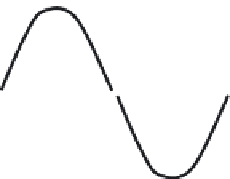Geoscience Reference
In-Depth Information
1 cycle
e or i
0
90°
180°
270°
360°
θ°
1
4
1
2
T
3
4
T
T
T
t,
s
1 period
FIGURE 11.56
Relationship between electrical degrees and time.
=
1
f
(11.46)
T
=
1
T
(11.47)
f
Note:
The higher the frequency, the shorter the period.
The angle of 360° represents the time for 1 cycle, or the period
T
; therefore, we can show the hori-
zontal axis of the sine wave in units of either electrical degrees or seconds (see Figure 11.56).
The
wavelength
is the length of one complete wave or cycle. It depends on the frequency of
the periodic variation and its velocity of transmission. It is indicated by the symbol λ (lambda).
Expressed as a formula:
λ=
Velocity
Frequency
(11.48)
11.7.11.4 Characteristic Values of AC Voltage and Current
Because an AC sine wave voltage or current has many instantaneous values throughout the cycle,
it is convenient to specify magnitudes for comparing one wave with another. The peak, average, or
root-mean-square (RMS) value can be specified (see Figure 11.57). These values apply to current
or voltage.
11.7.11.5 Peak Amplitude
One of the most frequently measured characteristics of a sine wave is its amplitude. Unlike DC
measurement, the amount of alternating current or voltage present in a circuit can be measured in
various ways. In one method of measurement, the maximum amplitude of either the positive or the
negative alternation is measured. The value of current or voltage obtained is called the
peak voltage
or the
peak current
. To measure the peak value of current or voltage, an oscilloscope must be used.
The peak value is illustrated in Figure 11.57.









Search WWH ::

Custom Search